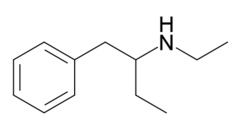N,α-Diethylphenethylamine
 | |
| Clinical data | |
|---|---|
| Other names | N,α-DEPEA |
| Legal status | |
| Legal status |
|
| Identifiers | |
| |
| CAS Number |
|
| PubChem CID | |
| ChemSpider | |
| Chemical and physical data | |
| Formula | C12H19N |
| Molar mass | 177.285 g/mol g·mol−1 |
| 3D model (JSmol) | |
| |
| |
N,alpha-Diethylphenylethylamine (N,α-DEPEA, 2-ethylamino-1-phenylbutane, EAPB) is a close chemical analog of methamphetamine which has been sold as a designer drug.[1][2][3] It was originally patented, by Knoll Pharma as one of several analogs for pharmaceutical applications. In animals models these analogs showed properties of cognitive enhancement and increased pain tolerance.[4] Nevertheless, this class of compounds was never developed into a medicine. N,α-DEPEA has not been studied in humans, but experts such as Pieter Cohen, an assistant professor of medicine at Harvard Medical School, expect it to be less potent than methamphetamine but greater than ephedrine.[5]
In January 2013, the Korean authorities reported seizing a large quantity of the pure material, predicting it would soon be found on the market.[6]
In August 2013, the first paper was published on N,α-DEPEA being found in the pre-workout supplement Craze.[4]
In October 2013 it was announced that N,alpha-diethylphenylethylamine was found in biologically significant amounts in the pre-workout supplements Craze (marketed by Driven Sports, Inc.) and Detonate (marketed by Gaspari Nutrition). It was claimed to be Dendrobium extract.[5][7][8]
See also
References
- ^ Marzena Wójtowicz, Anna Jarek, Katarzyna Chajewska, Ewa Turek-Lepa, Dorota Kwiatkowska (November 2015). "Determination of designer doping agent – 2-ethylamino-1-phenylbutane – in dietary supplements and excretion study following single oral supplement dose". Journal of Pharmaceutical and Biomedical Analysis. 115: 523–533. doi:10.1016/j.jpba.2015.07.025. PMID 26311473.
{{cite journal}}: CS1 maint: multiple names: authors list (link) - ^ Victor Uralets, Mike App, Sumandeep Rana, Stewart Morgan, Wayne Ross (January 2014). "Designer phenethylamines routinely found in human urine: 2-ethylamino-1-phenylbutane and 2-amino-1-phenylbutane". Journal of Analytical Toxicology. 38 (2): 106–109. doi:10.1093/jat/bkt121. PMID 24451085.
{{cite journal}}: CS1 maint: multiple names: authors list (link) - ^ "2-Ethylamino-1-phenylbutane". Cayman Chemical. Retrieved 4 November 2015.
- ^ a b "Identification and quantitation of N,α-diethylphenethylamine in preworkout supplements sold via the Internet". Springer. August 2013.
- ^ a b "Craze manufacturer disputes NSF's discovery of drug tainting". Nutraingredients. October 17, 2013.
- ^ "Identification of N-ethyl-α-ethylphenethylamine in crystalline powder seized for suspected drug trafficking: A research chemical or a new designer drug?". Springer. January 2013.
- ^ "A methamphetamine analog (N,α-diethyl-phenylethylamine) identified in a mainstream dietary supplement". Wiley. October 14, 2013.
- ^ Warning issued over CRAZE sports supplement. New Zealand Herald, 13 November 2013
